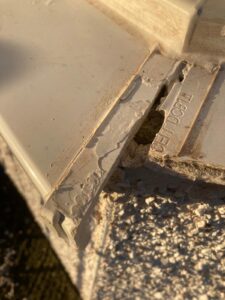Case Study Information
- Welsh programme: ORP
- Type: Retrofit
- Stage: Operational
- Design standard: Building Regulations
- Design standard: PAS 2030/35
- Design standard: WHQS
- Heating measure: Solar PV
- Other measure: Battery storage (BESS)
- Other measure: In use monitoring
As part of ORP 3.1 an additional 42 properties on Rhydwen Drive have had retrofit works carried out (Scheme 1). Works included external wall insulation (EWI), loft / roof insulation top up to current building regulations, replacement of existing roof and all associates, roofline / water goods. Solar PV and batteries added to the property as well as intelligent energy systems (IES) and environment sensors.
The project is working towards an EPC / SAP rating of C75 or above on all 42 properties.
Project learning
To maintain a high quality snagging during the 12 months defects period.
Signs to look out for are:
- EWI around window sills check these are sealed correctly and water runs off the sills and does not collect.
- Check where rooflines have been extended
- Check reclips for guttering / ensuring new rainwater goods / guttering are fitted correctly to prevent water penetrating the EWI
- Check drains for blockage due to excess pebbledash chippings as the first few months chips bed in – need to make sure area around the house is swept periodically for excess chips that have fallen from the render
- Remove chimneys in the future, to remove shadow from Solar PV
- Decision made to no longer add batteries to properties as concerns about maintenance and meeting future PAS 63100 and IET Code of Practice 3rd Edition requirements
- Sensors for IES and environmental systems life time running costs will be considered in future as new suppliers enter the market as a cost saving measure
Project innovation
Due to high living costs, we are looking at innovative ways to reduce the strain on our tenants finances. A Wetherby Mineral EWI system was used to insulate existing cavity wall properties to reduce heating bills and to optimise thermal performance and internal comfort. Additionally, JM Renewables, a local PV supplier, were used to install PV and inverters for each property; and each have a battery to collect additional energy during the day to reduce bills overnight.
Sensors have been added to collect data for decarbonisation for Welsh Government. The data from the sensors also supports our maintenance team by looking for risks such as overheating, condensation, poor ventilation, mould and fuel poverty.
Challenges
Tenant engagement could be challenging and this has led to a review of best practice and where improvements can be made.
Communication and checks of physical work with sub-contractors / site operatives – unforeseen issues such as language barriers as not all workers on site spoke Welsh / English.
Review of batteries for PV systems.
A cost benefit analysis was made as there were issues such as software updates, connectivity issues for the IES (requiring tenant to have WiFi).
Challenge to find defects after works have been complete, but during defect period. For example, damage to bell cast beads and finished render systems caused during demobilisation period / site dismount (removal of containers, gantries and scaffold poles).
